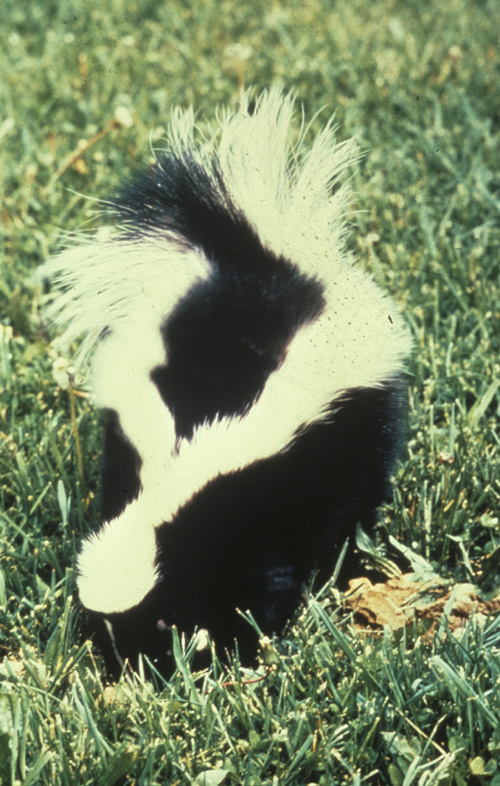Striped Skunks are common in Connecticut. They have a small head and pointed snout. They have black fur. White fur on the top of their head usually splits into two distinctive white stripes down their back, extending down the sides or tops of their bushy tail. The stripes may vary in width, and sometimes merge so that the entire back of the skunk is white. A narrow white stripe runs down the middle of their forehead to the nose. The tail is 7 to 15 1/2 inches long. They weigh 6 to 14 lbs.
Striped Skunks range through almost the entire continental US and the southern parts of Canada. Preferred habitat for these skunks are fields or brushy areas, mature forest is less-preferred. They are adaptable and they can live in residential and urban areas. They are primarily nocturnal, but healthy skunks may be observed during daylight. Skunks are not typically active year-round and enter dormancy (not hibernation) for the winter in most areas.
Skunks are omnivorous. They eat small mammals, eggs, insects, amphibians, and fruits. They eat human garbage.
Skunks in New England mate in late February through early March. The third week of March appears to be their most active breeding period in this area, and males may frequently seen wandering, seeking females. 4 to 8 babies are born in May or early June. Skunks are not monogamous and females care for the young.
Skunks are solitary except when a female is raising her young, and sometimes communal denning occurs in the winter They use natural cavities in rocks or under trees or abandoned burrows of other animals for dens. They can also dig their own.
Skunks begin to eat more heavily in autumn and build up fat for the winter. In the cold months skunks enter a deep sleep that is not true hibernation, their body temperature only drops a few degrees. They sleep for weeks at a time but can awaken and come out for awhile if weather truns milder. In some more southern regions they may be active all winter.
Skunks are fairly easy-going animals and don't often attack unless provoked. They can afford to be, for they are equipped with a formidable defense mechanism. Skunks have two musk glands equipped with aimable nipples under their tails. These glands hold enough stinky skunk musk for 5 to 6 sprays. Skunks can accurately spray their musk 10 to 15 feet and the mist may reach 30 feet or more. The spray reeks to high-heaven, stings the eyes, may temporarily blind a victim and can induce nausea. It's also a lasting stink and may cling to whatever was sprayed for many days. Several different sulfur-containing compounds give skunk musk its powerful stench. A threatened skunk will chatter its teeth, turn its back to the threat, stamp its feet and lift its tail before spraying. If confronted by a skunk in threat-mode your best bet is to back very slowly and quietly away. It is best not to approach or startle skunks.
Skunks frequently dig for grubs and larvae. Skunk-made holes in yards may annoy homeowners. Skunks also sometimes take up residence under decks or in crawl spaces by human habitation. Close off entrances to such spots with wire mesh, being sure to bury it about a foot deep to prevent the skunk digging back in. Do this when skunks are absent after dusk. Scattering flour near an entrance hole can show footprints indicating the skunk has left for the night. It is best not to close off holes from May to August so baby skunks are not trapped. The scent of skunk musk on the propery or the sight of a skunk trundling through the neighborhood is not a sign of trouble. It is not necessary to try and trap and remove skunks that coexist with humans just because they are there.
Skunks can carry rabies, as can all mammals. One shouldn't approach wild animals anyway, but skunks or other animals behaving stangely and exhibiting symptoms such as lethargy, unprovoked aggression, apparent disorientation, lack of coordination or lack of fear should be particularly avoided. If you suspect a rabid skunk is on your property, contact the Connecticut DEP or your local animal control officer. Rabies spreads to other mammals (including humans) through bites or other contact with infected saliva. Untreated rabies is always fatal, so it is a disease that must be taken seriously.
Neat Fact
A common folk-remedy for removing skunk odor is tomato juice. Research (William F. Wood, The Chemical Educator) has shown that the perceived effectiveness of this and other such treatments (lemon juice, vinegar) is due largely to olfactory fatigue. At high concentration of an odor, the human nose stops detecting the odor. Something like tomato juice will be smelled over the skunk odor after long exposure, leading to the belief it was somehow neutralizing the original smell.
A recipe that does show effectiveness in reducing skunk odor is 1 quart of 3% hydrogen peroxide (available at drug stores), 1/4 cup baking soda, and one teaspoon of liquid detergent. An animal or object can be washed in this solution and rinsed after 5 minutes. Keep the mixture out of the eyes and ears, and you may want to color-test a small portion of the solution if treating objects or fabric. Not that you'll want to keep them if you can't de-stink them.
Hydrogen peroxide is an oxidizer that can chemically change the sulfur compounds of the skunk musk to less-stinky compounds (sulphonic acids). Note that the solution will lose effectiveness if stored for very long so mix up a fresh batch as needed. It also releases oxygen over time so attempting to store it in a closed container will result in a build-up of pressure. A water-bleach solution can be used on inanimate objects, but not on humans or pets please.
